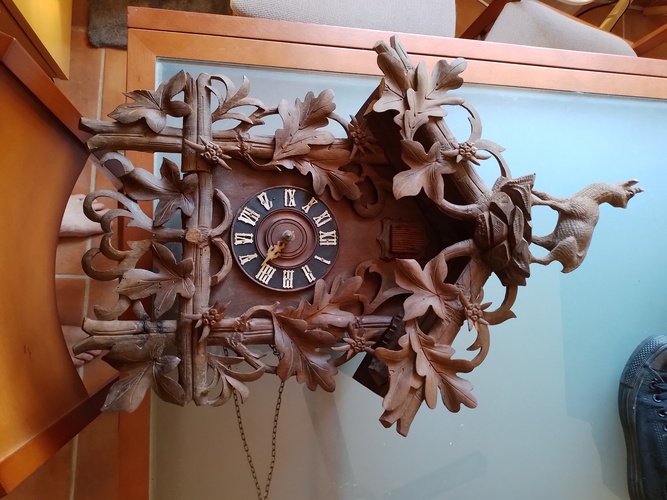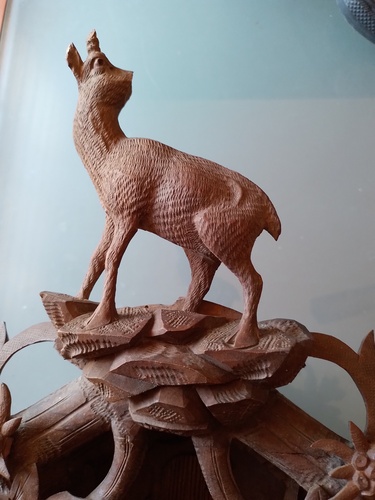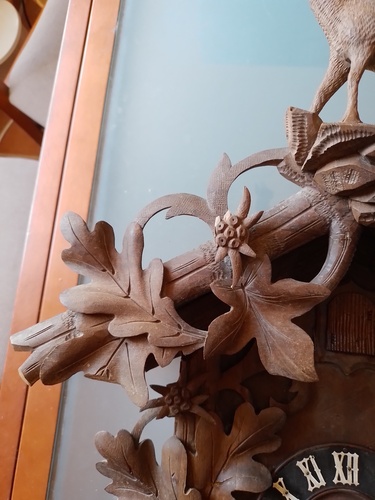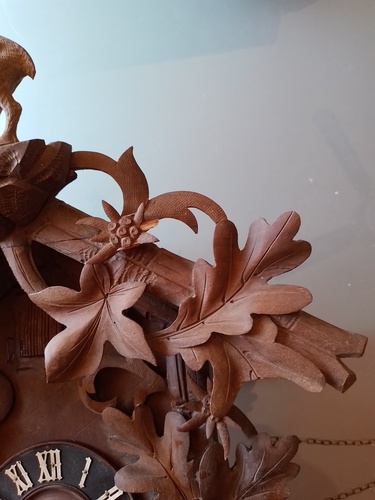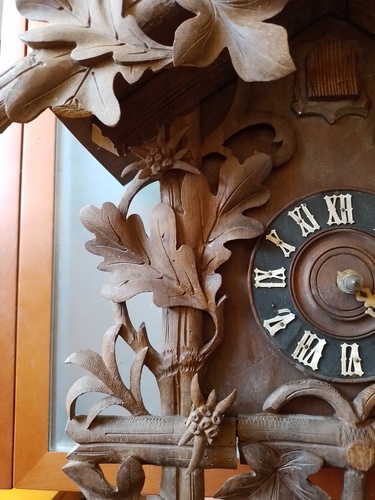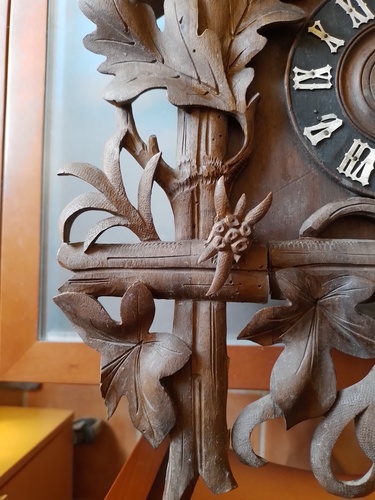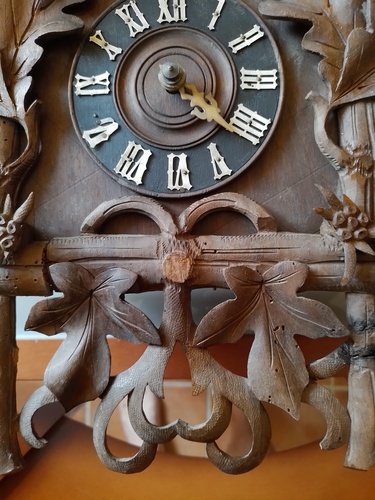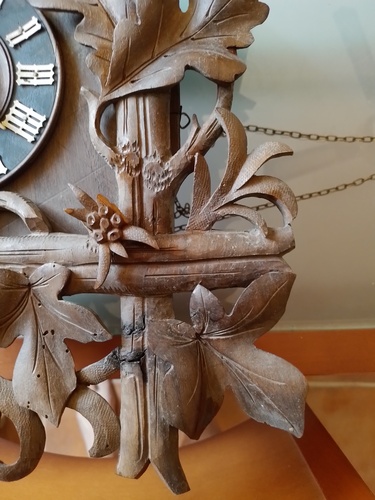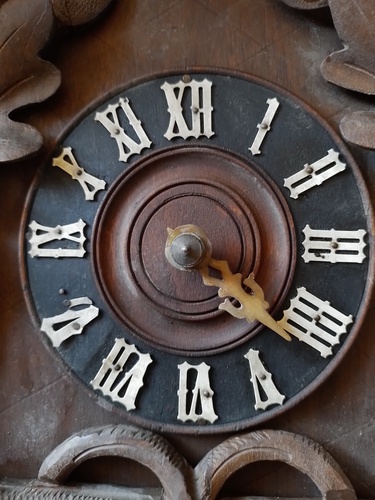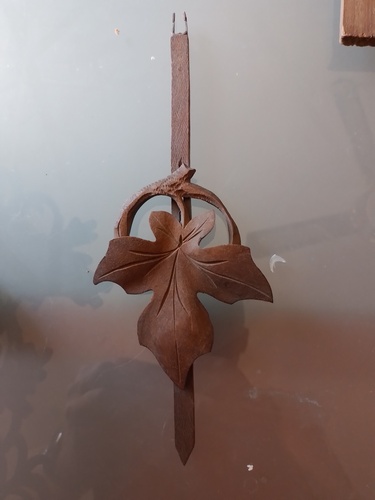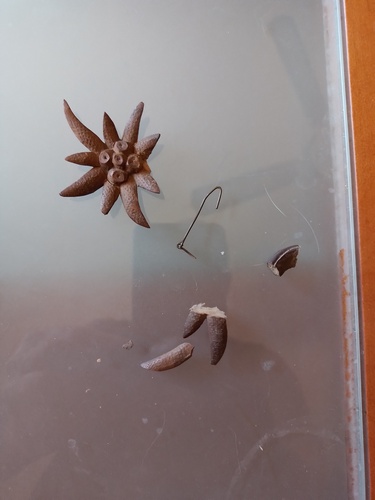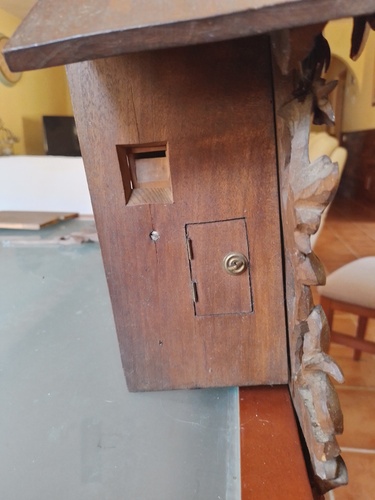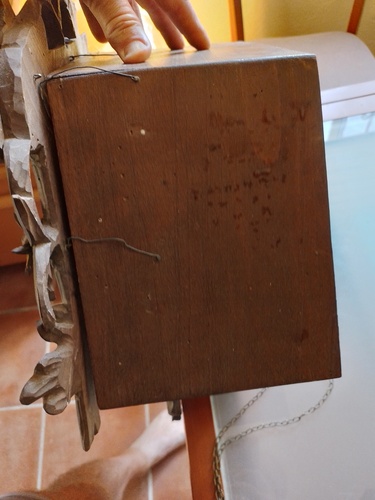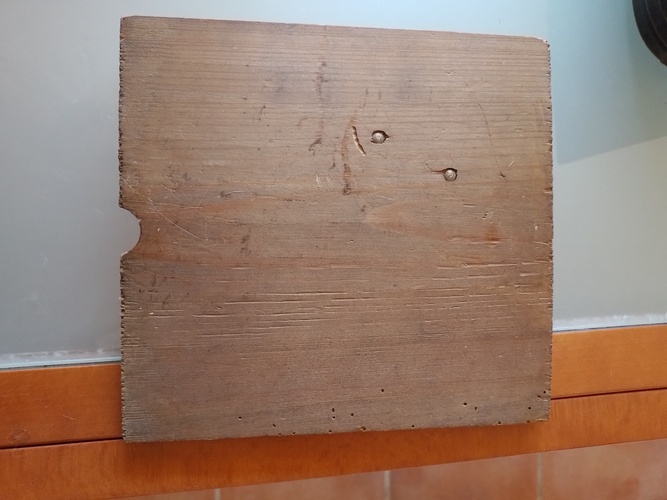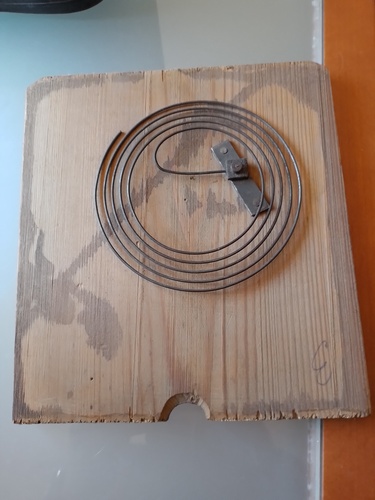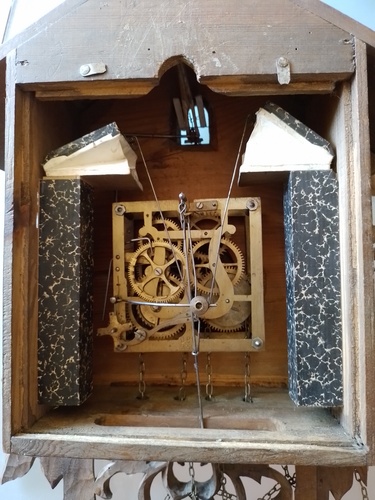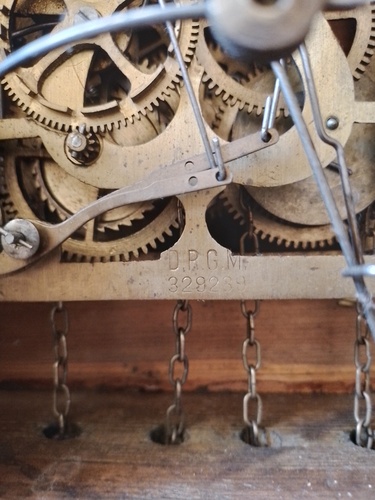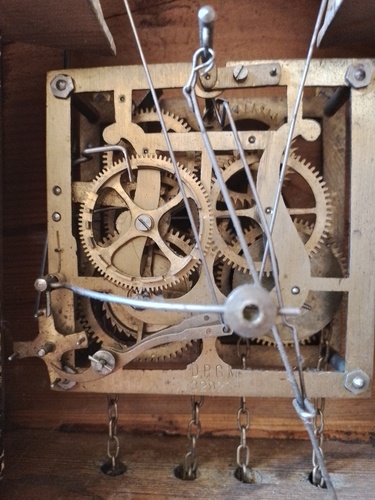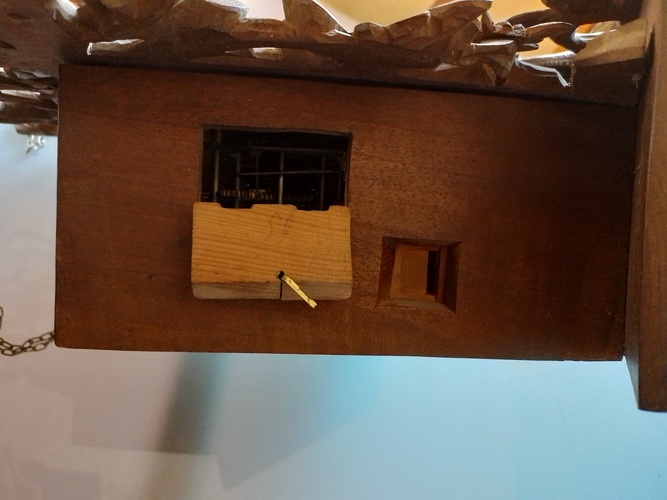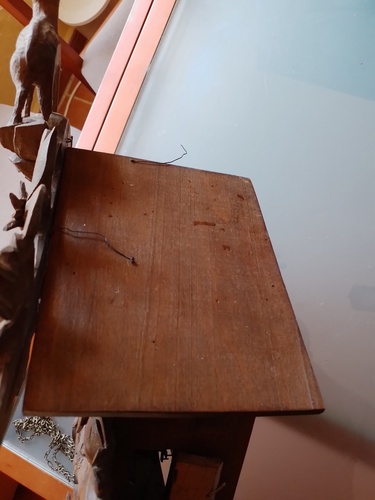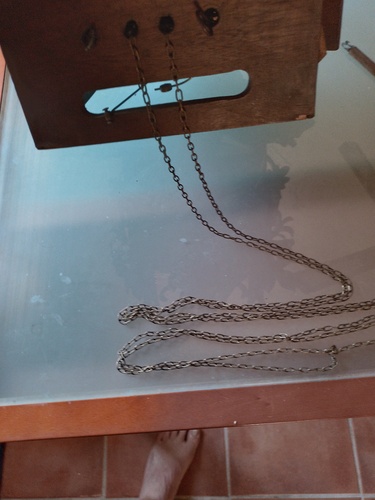Antique Black Forest large cuckoo clock believed to be by Johan B Beha. No markings on the case but there is a DRGM number on the mechanism which is 329239. The clock needs significant refurbishment as there is a lot of damage to the decorative woodwork and one of the hands is missing. The clock is believed to have a double fusee movement.
Unknown


Hello Nick,
Thank you for sending in this cuckoo clock to mearto.com for an appraisal. Sending in these close up photos of the wooden parts are difficult to identify, and we are obviously dealing with a cuckoo clock that was very well made but now needs an expert cabinetmaker to put it back together. So, let's give it a try to see what conclusions we can make with this item.
TITLE:
Stained and hand carved, Linden wood, said to have a double fusee movement driven by link chains, 8 day hour duration wall hung cuckoo clock, unsigned, DRGM patent number on the mechanism is 329239, dating to 1907,attributed to Johann Baptist Beha (1815-1898) sons, Lorenz (1865 - 1941) and Engelbert (1866 - 1949) Beha, in Eisenbach, Black Forest region, Germany made circa 1900-1910. [When Johann Baptist Beha died in 1898, his sons Lorenz (1865 - 1941) and Engelbert (1866 - 1949) continued with the company in Eisenbach, where it likely was made circa 1900-1910. Their manufacturing program consisted of; cuckoo/quail clocks, cuckoo clocks with echo, weight operated clocks, spring powered clocks, trumpeter clocks, monk ringing a monastery bell, calendar clocks, etc. The largest export market of Beha clocks was to the United Kingdom and Russia. In Saint Petersburg Beha even operated their own warehouse, from there the clocks were marketed to different countries, but with the outbreak of World War I, the St. Petersburg warehouse was closed. The Beha enterprise struggled during the 1920s to recover the lost export market facing extremely difficult economic times and during the 1930s, with the onset of the economic dictatorship of the "Hitler Regime" in the year 1933, the use of brass and copper was strictly rationed, although the production continued on a very limited scale until 1938. But finally after the World War II the production was stopped forever in 1956.]
CASE: First let me state that you cannot diagnose the maker from the carved case because the same carvers sent out the same cases to many makers in the Black Forest. However, a fine carver made this case and of course it is in a style that the fine clockmakers would use. It is a Swiss chalet style wall clock powered by 2 CHAIN DRIVEN fusees. The carving along the canted roof is quite fine with a wolf howling in the night at the moon done expertly. He is flanked along the canted pediment by circles of vines and well executed oak leaves with seed pods. The eaves hold the same dome shaped door for the emergence of the cuckoo bird hourly to make his call as noted in your signed clock Oak leaf carvings proceed down the side of the chalet timbers where they meet the tree limb that runs horizontally at the chalet base and the side timbers proceed past that point for the explicit purpose of adding more ornamentation and balance to the design of the csae. The vines between the leaves are rounded out nicely and this rounding of the vines continues throughout the case. Seedpods occur at the intersection of the base and vertical timbers. The facade of the house is simpler than your other clock by Beha because of the lack of tiles on the facade of the house. Extending up and down from the center of the base timber was a wonderful symmetrically shaped rounded vine, parts now missing that ran above and below the timber. Of note is the oak leaf pendulum bob. (On page 79 of Justine Miller's book 'Rare and Unusual Black Forest Clock's are pendulums carved in the early 19th century and figure 12 has a "finely carved pendulum with an intricate oak leaf and vine design removed from a cuckoo clock made by Johann Baptiste Beha. Your pendulum bob is not quite as intricate in the vine work but has the same basic arrangement of oak leaf and vines (as time progressed everything was made simpler to save on money.) The sides of the case are fairly straightforward and the back of the case can be removed and holds a simple wire coiled gong attached to the backboard. . . .
DIAL: The dial is made in two parts and is simpler than the earlier dial you showed me on your other Beha clock. The outer ring is a blackened or ebonized colored wood with applied plastic or iveroid white Roman Gothic hour chapter ring. The single Gothic hand is truly made of bone and it likely original. The hands are bone and carved in a beautiful floral form. There are no winding holes in the dial. The central ring has two concentric circles rather than a carved floral form, all in the later and simpler style used in cuckoo clock cases. The dial is, of course unsigned. . . . .
Movement: This is a square fenestrated brass plate movement with front and rear plates. Note the corners are connected with posts that lock on the back plate with nuts and screws. Using nuts and screws suggests to me a mechanism made post 1900. Cotter pins were used prior to the turn of the century. On brass movements one might find the name Beha (very rare to find his name) but it may be the time when his sons took over the business and the name of the business remained unchanged. (The business did not end until the middle years of the 20th century.) One of Johan's brass movement plates that I have seen and is pictured has an ovoid top to the movement which is otherwise rectangular and late, made with washers and screws securing the plates. I do have a comment from the text I am reading that states Johan made brass movement cuckoo (and quail) clocks which were made with chain driven movements, with simple spring driven movements and also with the premier 8 day fusee movement. All known cuckoo clocks made of fenestrated or skeletonized brass movements are said to be of the simple spring variety (according to the text)." Beha did not manufacture skeletonized brass cuckoo clocks fitted with 8 day solid brass fusee movements." So, that speaks against this being a clock made by Johann. Johann by the way was considered in his time, to be the inventor of both the cuckoo clock and quail clock, and celebrated for it. Modern evidence has destroyed that theory however. There is a lyre shaped plate design within the back plate that appears to connect to the two fusee springs. I am not familiar with Johann using that type of design except with movement made for him by a nearby clockmaker.
After 1866 brass movements became more popular but Johann refused to leave the wooden plate designs that he continued to make. He started to use brass plates in 1868/69. The firm did not begin using skeletonized brass plate movements until 1904, while prior to that they made primarily solid brass movements. Sources of skeletonized movements were outsourced to "Burger of Shonach". **The Burger movements acquired by the Beha firm included both the "lyre and square plate designs". Johan, when building his fusee movement clocks in wooden plate and post type movements cut the fusee cones to use ONLY gut cable and not chain driven. When fusee movements by him are found with chains they have usually replaced the catgut that he primarily used. There are two bellows for the cuck-coo bird's call flanking the movement. . .
Conclusion: This will remain an unresolved issue but a finely made clock. My feeling is that the movement was made using a 'Burger of Shonach' movement with touches of the early Johan Beha designs seen in the pendulum bob and in the general design of a fine case. I assume you know what a fusee looks like and that this movement has two of them using chains. Although likely converted I think it you want to make an attribution I would use a date of 1900-1910, the years that they registered their patent with the German government. The makers would be working for Johann Baptist Beha (1815-1898) sons, Lorenz (1865 - 1941) and Engelbert (1866 - 1949) Beha, Eisenbach, Black Forest region, Germany made circa 1900-1910.
That is about the closest I can get for you with this movement and the patent dating. So, we can say it was originally conceived by the father who trained his two sons who managed to carry the business well into the 20th century using some of his eye for beauty and proportion when choosing his cases.
Condition is as you know, 'fair' with a need for proper replacement of parts and being finished correctly. As it sits, it appears to require quite a bit of effort to restore. However, after it is done you will have a very handsome looking cuckoo clock. I would place a fair market value of $300-$400 on this clock, but with good restoration it would be a few hundred dollars more at most.
Thank you for asking me to look at this clock and appraise it. Unfortunately, it was made after Johann died.
Thank you for choosing mearto.com for this appraisal.
My best,
David
Please log in to your Mearto account to contact this seller or make an offer on this item.

